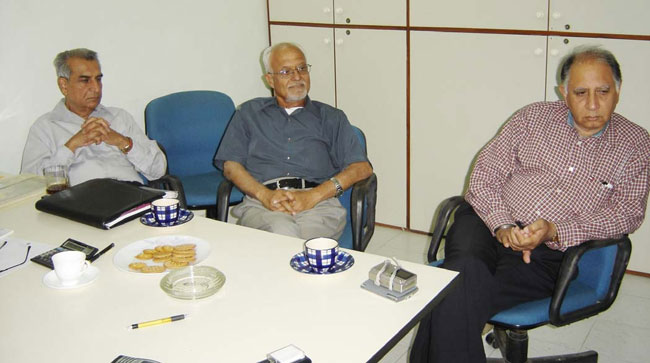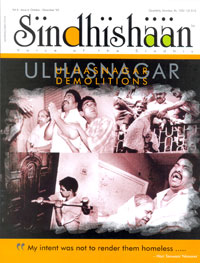“WHY DO WE LOVE OUR MOTHER?”
By Mahesh Vaswani
NO INTERCASTE MARRIAGES,
KEEP THE SINDHI DNA ALIVE !
 “CAN YOU TELL ME WHY DO YOU LOVE YOUR MOTHER? WHY DO WE LOVE OUR CHILDREN, GRAND CHILDREN? WHAT IS THE MOTIVE? AND IN THE FIRST PLACE IS THERE NEED FOR A MOTIVE? SIMILARLY SINDHI LANGUAGE AND CULTURE IS AKIN TO THE MOTHER, TO BE REVERED AND PROTECTED WITHOUT ANY MOTIVE!” This was the thundering response of Prem Lalvani when he was asked to explain how to motivate the youth to learn Sindhi language.
“CAN YOU TELL ME WHY DO YOU LOVE YOUR MOTHER? WHY DO WE LOVE OUR CHILDREN, GRAND CHILDREN? WHAT IS THE MOTIVE? AND IN THE FIRST PLACE IS THERE NEED FOR A MOTIVE? SIMILARLY SINDHI LANGUAGE AND CULTURE IS AKIN TO THE MOTHER, TO BE REVERED AND PROTECTED WITHOUT ANY MOTIVE!” This was the thundering response of Prem Lalvani when he was asked to explain how to motivate the youth to learn Sindhi language.
This correspondent had an opportunity to get an insight into the hearts of PREM LALVANI, KISHORE LALA & NAND BELANI, Chairman, Vice President & the Treasurer of Alliance of Sindhi Associations of Americas Inc. respectively.
It is in the West, particularly the USA, where morals and values in the social fabric are fast degenerating, that these three stalwarts along with several others have been at the helm of affairs to keep the Sindhi language and culture alive. Sindhis have been primary settlers in India and their roots are now deepest in the Indian soil and as such the NRIs were taken aback to learn that my questions reflected the fact that Sindhis in India too, are losing interest in the language, culture and the ethos of their own community. Commenting on the fact that the students of the current generation studying in English medium schools and colleges hardly speak Sindhi, leave aside being capable of writing or reading in their script - “If you can teach your child how to walk, how to eat, how to talk, you, as a parent, are responsible for imparting the importance and knowledge of the Sindhi language and its culture. The parents have to ignite the spark”, says Kishore Lala who is an advocate from the University of Sind(now in Pakistan). Having taken over the cause of keeping the community united and its culture alive since 1978, Lala has come a long way in life even on foreign soil. He related a very touching incident he had experienced. “A young father, watching a show put up by his kid and other tiny tots of his age group – presented in Sindhi, looked upto me with tears in his eyes and said, ‘Uncle you lost our generation. Make sure you don’t lose this generation’!” Yet another crusader, Nand Belani who is a BA and a mechanical engineer based in Chicago and who was here for preliminary preparations for the International Sindhi Sammelan, is thrilled that the global event is being held in India. He feels that encouraging greater participation of the youth in the community events and celebrations will surely kindle their interest and egg them onto learning the language. He too echoes the views of Prem Lalvani and feels that just like one doesn’t need a motive to love one’s mother, there should not be any need of motives to love and live with your own language, culture and traditions. And this is the response to the invariably common “What’s the use? How will it help being successful in life?” ………..put forth by the youth and at times their parents to “why don’t you speak Sindhi?” For getting admission to education institutions under the Sindhi quota they cry hoarse “I’m a Sindhi”, but forget all about the Sindhi language once the admission has been granted.

(From L - R, Prem Lalvani, Kishore Lala and Nand Belani)
When asked if orgasnising dance and cultural functions or sammelans are sufficient to ensure the survival of the Sindhi culture, language and tradition on this planet, Lalvani says many organisations are already doing good work in the field of keeping the Sindhi culture alive and anyhow we have to make a start somewhere. We all have to learn the importance of our traditions, culture and language for the survival of our very identity as a Sindhi, as an Indian and ultimately as a citizen of the World. Your surname will continue to be with you and identify you as a Sindhi citizen of the World.
Putting me on the defensive all three NRI soldiers of the Community ask “Then what is the difference between organised society and primitive world of the pre medieval times? What will you tell your children who you are? What will you tell the state and the world about your culture and language?” They say we can’t allow the community to drift towards becoming cultural orphans. We have to come alive to this cause and work hard. With all those who have been born in the Sindhi community and for the cause of every Sindhi on this planet.
Discouraging the youth from intercaste marriages is also an important step needed to keep the DNA of the Sindhi community alive. Not because of anything against the other communities per se but to preserve the identity, especially overseas, in the US for instance.
Suave and soft spoken Lalvani wants the Sindhis to be taught the importance of marrying a Sindhi only. “Intercaste marriages are destroying the identity of a Sindhi family. A girl marrying a non-Sindhi would find it difficult to pursue Sindhi culture or let her children adopt Sindhi as a mother tongue. Likewise a Sindhi groom marrying a non-Sindhi girl can’t impose on his wife that she learn Sindhi and teach the same to the children. Also the girl, would not be able or expected to dilute or forget her own culture and language. She would want her children to learn her mother tongue too! And why not!”
“Then a conflict of interest arises, often ending up either in marital discords or resulting in the wiping out of the cultural identity of one of the married partners in such intercaste or inter religion marriages”, he adds. Agreeing with Lalvani, Kishore Lala too emphasises the need for discouraging Sindhi youth from having matrimonial alliances with non-Sindhis. “The very fabric of the Sindhi community will get torn beyond any repairs if the Sindhi youth are not educated about the importance of avoiding intercaste marriages. Arranging matrimonial alliances is a highpoint of the Sammelan held in the US giving Sindhi families spread thinly across US an opportunity to strike matrimonial alliances.”
These NRI Sindhis have no compulsions, and all of them are well placed in society, but they are the real torchbearers of the Sindhi community even on alien soil. They are not anti intercaste marriages, but they all have one mission. They love their mother tongue, their community and culture above every thing else. Keeping the Sindhi community and culture alive is their primary mission in life.
Yet another major step is to teach Sindhi language to our children in their tender age itself says Prem Lalvani. We need to set up more Community centers where Sindhi children could be taught to read and write in their script. There should be youth centres for the Sindhis exclusively
and also the government should be approached for more facilities and funds for Sindhis. The youth should be motivated to learn Sindhi language by hosting essay, drama and elocution competitions at the City, State and National levels with certificates of achievements and other attractive prizes.
My memories go back to the few meetings I had with stalwarts like late barrister Hotchand Advani, at his 1st floor chambers in the Bombay High Court, philanthropist and educationist – the late Mr. K.T. Shahani at his New Marine Lines office, late poet and cult figure of the Sindhi community Ram Panjwani, my Godeous friend, guru, philosopher, constitutional expert and one of the biggest crusader for the cause of all Sindhis – Nari Gursahani, late poet Gobind Malhi. All these towering personalities loved to converse in Sindhi language only. Their love for the language, for fellow Sindhis, the culture, the traditions, the ethos and art was boundless.
It is because of such dedicated personalities the community has produced that the Sindhi language is atleast surviving in pockets in India. These torchbearers of the community in independent India took pains to personally hear the fellow Sindhis in person and redress their problems to the best of their ability. They were all successful, financially well off, but still chose to dedicate most of their lives’ efforts to the cause of the community. Though this is good news for the Sindhi activists, it is also true that most of the youth in the age group of 14 to 25 today are having fractional or no knowledge of Sindhi language at all.
The International Sindhi Sammelan, which will be the 12th of its kind, is to be held in India this year. It has some of the most compelling orators, dedicated community leaders and activists from the world over who promise to galvanise the Sindhi community in India afresh. The Sindhis are one of the most ancient and advanced civilizations. I am sure that besides the organizers, the delegates participating in the annual global event will give a new impetus and accelerate the pace of the community’s interest in their own culture, heritage, art, ethos, language and fellow Sindhis.
Seeing the passion and enthusiasm in their emotional outpouring, I’m more than certain that the 12th International Sindhi Sammelan will be a roaring success.


